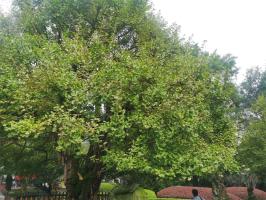Does Planting Trees Add CO2 to the Atmosphere?
Planting trees is often touted as a solution to climate change because trees absorb carbon dioxide (CO2) from the atmosphere during photosynthesis. However, some researchers have raised concerns that the act of planting trees might actually have unintended negative consequences by adding CO2 to the atmosphere. So, does planting trees really add CO2 to the atmosphere, and if so, how?
What is the Carbon Cycle?
In order to understand the relationship between trees and CO2, it’s important to first understand the carbon cycle. The carbon cycle describes the movement of carbon through the Earth’s atmosphere, land, and oceans. Carbon naturally moves between the atmosphere and land through processes like photosynthesis, respiration, and decomposition. When a tree engages in photosynthesis, it absorbs CO2 from the atmosphere and converts it into organic matter. This organic matter is then used by the tree in growth and development, and some is eventually returned to the atmosphere through respiration and decomposition.
What are the Concerns?
While the carbon cycle is a natural process, there are concerns that planting trees might disrupt the cycle and increase the amount of CO2 in the atmosphere. The primary concern is that planting trees can lead to deforestation, which can actually result in a net increase of CO2 in the atmosphere. When forests are cut down, the stored carbon in the trees and soil is released into the atmosphere. Additionally, the act of planting and caring for new trees requires energy and resources, which can also release CO2 into the atmosphere.
What is the Available Evidence?
There is some evidence to suggest that planting trees can have a positive impact on reducing CO2 in the atmosphere, but this depends on the context in which the trees are planted. For example, if a forest is planted on previously deforested land or non-forested land, it can sequester carbon and lead to a net reduction of atmospheric CO2. However, if a forest is planted on land that was already forested or where there is a high likelihood of future deforestation (e.g. due to logging or development), it may actually result in a net increase of atmospheric CO2.
Conclusion
Overall, planting trees can be an effective tool in reducing atmospheric CO2, but it must be done thoughtfully and in the appropriate context. It is also important to consider the entire life cycle of a forest, from planting to harvesting, and the potential for unintended consequences like deforestation. While planting trees on its own may not be a comprehensive solution to climate change, it can be one step towards reducing our carbon footprint and promoting a healthier environment.

 how many times do yo...
how many times do yo... how many planted tre...
how many planted tre... how many pine trees ...
how many pine trees ... how many pecan trees...
how many pecan trees... how many plants comp...
how many plants comp... how many plants can ...
how many plants can ... how many plants and ...
how many plants and ... how many pepper plan...
how many pepper plan...






























